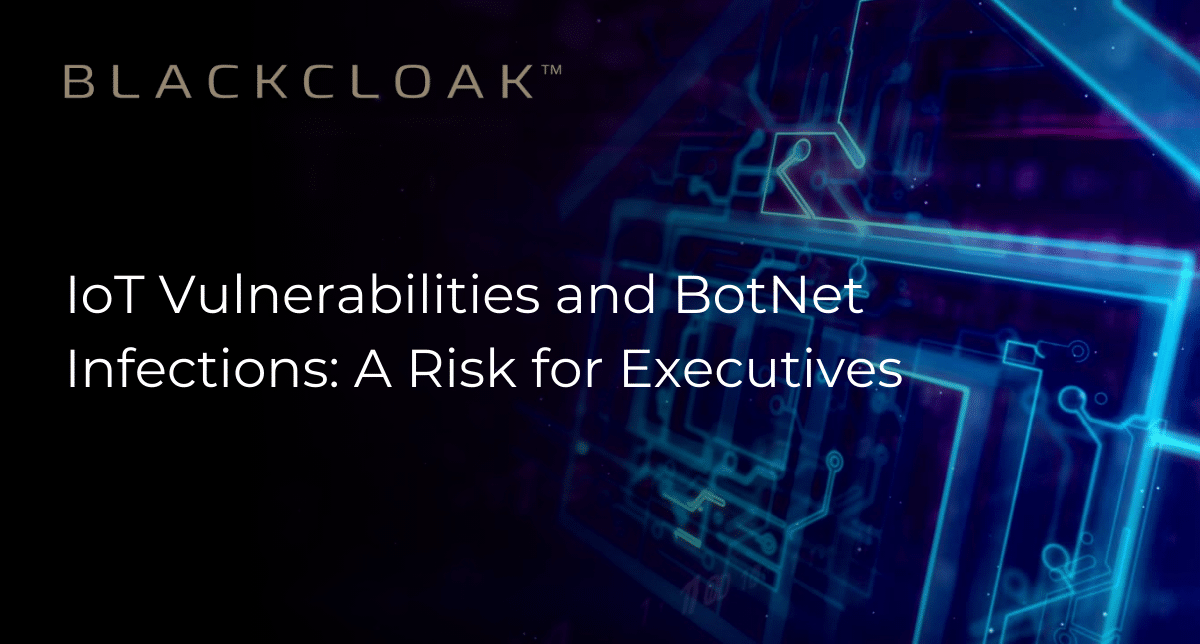IoT Vulnerabilities and BotNet Infections: A Risk for Executives

The Internet of Things (IoT) has become a cornerstone of business innovation and efficiency. However, the rapid proliferation of IoT devices also introduces significant cybersecurity risks, particularly in the form of IoT vulnerabilities and botnet infections. These risks pose a direct threat to executives, who often use these technologies both personally and professionally.
IoT devices are interconnected gadgets that communicate over the internet, ranging from smart home appliances to sophisticated industrial sensors. While they offer convenience and operational benefits, they also expand the attack surface for cybercriminals. IoT vulnerabilities can be exploited to create botnets—networks of infected devices used to launch cyberattacks such as Distributed Denial of Service (DDoS) attacks, data theft, and more.
The Executive Risk of IoT Vulnerabilities & BotNet Infections
Executives are prime targets due to their access to sensitive corporate information and their influence within their organizations. A compromised IoT device within an executive’s personal ecosystem can serve as a gateway to broader corporate networks, leading to significant security breaches.
Statistics Highlighting the Threat
- Botnet Activity: In 2023, botnets saw a 25% year-over-year increase in activity, with certain botnets comprising a significant portion of all detections.
- IoT Attacks: There was a 500% increase in overall IoT attacks year over year, with the Mozi botnet accounting for a large percentage of the total IoT attacks detected.
- Exploited Vulnerabilities: Between early July 2022 and the end of January 2023, a substantial percentage of malicious binaries contained at least one exploit of a vulnerability, indicating a major increase from the previous year.
Real-World Examples of IoT Vulnerabilities & BotNet Attacks
- The Mirai Botnet: In October 2016, the Mirai botnet executed a massive DDoS attack against the service provider Dyn, causing major websites like CNN, Netflix, and Twitter to go offline.
- Ring Home Security Breach: Cybercriminals hacked into Ring’s home monitoring systems using weak, recycled, and default credentials, allowing them to access live feeds and communicate remotely with the devices.
Mitigating the Risks Vulnerabilities in IoT
To protect against these threats, executives must adopt a proactive cybersecurity strategy. This includes regular updates to device software, strong encryption and passwords for home networks, and a comprehensive understanding of the IoT devices in use.
How to Remove the Threat of BotNet Infections
To effectively remove the threat of BotNets, it is critical to first understand their communication and control mechanisms. Most BotNets rely on a centralized server for commands, although more sophisticated ones use a peer-to-peer system. Identifying and disrupting these command and control centers is a vital step in dismantling the BotNet. Additionally, individuals and organizations must ensure that their devices are not part of a BotNet by regularly updating software, employing robust antivirus solutions, and monitoring network traffic for unusual activity.
Furthermore, educating users on the importance of cybersecurity hygiene plays a crucial role in removing BotNet infections. Simple practices include:
- Avoiding clicking on unknown links in emails
- Not downloading attachments from untrusted sources
- Using strong, unique passwords
- Seeking the support of Real-Time Cybersecurity Incident Response Teams
For organizations, implementing advanced security measures like network segmentation, behavior analysis tools, and proactive threat hunting can detect and isolate infected devices quickly. Regularly scheduled audits and updates of security policies and technologies ensure that defenses evolve in step with emerging BotNet strategies, keeping networks secure and resilient against these pervasive threats.
True Protection against IoT Vulnerabilities, BotNet Infections, and More
IoT vulnerabilities and botnet infections represent a growing threat to executive privacy and corporate security. By staying informed and proactive, executives can mitigate these risks and safeguard their digital ecosystems. The statistics and real-world examples underscore the urgency of addressing IoT security challenges in today’s interconnected world.
Interested in learning how BlackCloak’s concierge cybersecurity protects executives, public individuals, and HNWIs against cyber threats? Request a demo today.










